-
Posts
223 -
Joined
-
Last visited
Content Type
Profiles
Forums
Downloads
Posts posted by pellelil
-
-
The last flightplans have been importede and bundled in the installer, and the installer have just been uploaded to AVSIM, so I expect it will go live within the next 48 hours.
-
The tutorialt video recorded for version 1.24 is now available using the link below. I still have a few flightplans to impoort (that should be bundled with the installer), and to build- and upload the installer to AVSIM, so I guess version 1.24 will be available within a few days. This version contains mostly improvements to the logbook/employment-feature released in previous version.
Version 1.24 tutorial video:
-
I plan to release version 1.24 within the next few weeks. Even though version 1.23 is less than a month old, I've been making many improvements to the new logbook/employment-feature. While developing the logbook/employment feature I was mostly "faking it" using my debug/cheat-form, and the majority of my focus was to make sure the data was stored/retreived correctly, that I had all the data I needed and that everything was robust, and working ... so I didn't do many "real flights" in the simualtor while developing this feature.
After the release of version 1.23 I decided to create myself a brand new logbook and do some "real flying". Having just bought the FSR500, I decided that in my new logbook I would only have an initial type-rating for this single aircraft, and then work my way up from there (in the aircraft-DB for version 1.24 the Piper PA-46 have been split in 3, so there are now specific types for both the M500 and M600). I then planed to take the FSR500 from KVRB (Vero Beach/USA) to EKYT (Aalborg/Denmark), but naturally I had to do it in multiple flights as the distance far exceed the range of the M500 (KVRB - KCPK - CYUL - CYZV - CYYR - BGGH - BIKF - EGPK - EKYT). Doing these flights I came to realize various improvements I would like to add to the program ... and it gave me something to do during the cruise-phase of those flights

Grab UTC-time and payload-/fuel-weight via FSUIPC
I am still a long way from being able to "record" and "analyze" the full fligt, but with the next version you no longer have to "write down" the various OUT/OFF/ON/IN-times on paper. If you have FSUIPC on your system, these (UTC)-times can be extracted from the sim with a push of a button (so during a full flight you would have to switch to FV 4 times, and each time press a different button). Pressing these buttons will both extract the UCT-times from the sim (while also logging the real-times), but it can optionally also extract your payload (at the start of the flight) and fuel-weights (both loaded block-fuel and remaining fuel):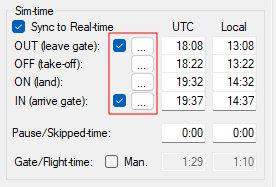
How to use these new OUT/OFF/ON/IN-buttons.
E.g. with the check-box next the OUT-time field checked, when you press the button, it will both obtain the UTC-time from the sim (based on the time-setting within the sim) and it will also obtain the amount of loaded payload and loaded fuel (block-fuel). The bullet-points below describe how/when to use these 4 new buttons, while you perform your flight:- Create/save the log-entry for the flight (as explained video describing the logbook/employment feature).
- Start your simulator and chose departure airport/gate and set the weather/time as you want.
- Setup and load your aircraft till the point where you are ready to leave the gate, or start taxi.
-
Switch to FV and ensure the checkbox is checked, and press the button next to OUT-time.
- Will update both UTC- and Real- OUT-times, and also update Actual payload, and Actual block-fuel.
- Taxi to the runway from where you are are taking-off
-
Switch of FV and press the button next to OFF-time
- Will update both UTC- and Real- OFF-times
- Take-off, fly the flight, and land
-
Switch of FV and press the button next to ON-time
- Will update both UTC- and Real- ON-times
- Taxi to the gate
-
Switch to FV and ensure the checkbox is checked, and press the button next to IN-time.
- Will update both UTC- and Real- IN-times, and also update Actual remaining-fuel.
- At this point the log-entry in FV can now be completed/commited
In order to use this new feature you must be connected to the sim using FSUIPC. I've only tested with the paid FSUIPC, but it should work just as well with the free version of FSUIPC. In settings you can choose if FV should connect with FSUIPC automatic or manually (using the "Connect" and "Disconnect" menu-items in the File-menu). I've chosen to simply automatic connect to FSCUIPC, and based on your settings you should hear the "Connected" and "Disconnected" sounds when connection is made or dropped. But if you for some reason don't want to use FSUIPC, you are still able to manually enter these times.
Make it more easy to load your aircraft according to load-sheet
In the GUI when hoovering the mouse over the various payload-fields the weight is now shown in the tool-tip window both as lb and kg, and the tool-tip window for the fuel-fields will both show the fuel as weight in lb and kg, along with the volume as US-Gallon and Liter (using 3 different densities for JET-A1, JET-A and AVGAS). Typically small GA aircraft have a left- and right tank, and for this reason all values are both shown in full, and half (what to load in both the left- and right tank). This will make it much more easy to dial in the correct payload/fuel-weights in the simulator, whether you use the default "loader" in MSFS, or your aircraft have its own dedicated loader (e.g. via a cockpit-tablet or perhaps via the FMS).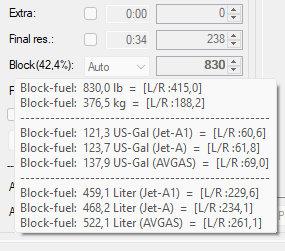
Regarding the various weight-fields defined for the aircraft-types in the database (and the Simulator-aircraft you create) my idea have always been that the weight of the crew should be ignored (expected to be included in the EOW of the aircraft). While this works fine for large commercial aircraft, it does not work as well for small GA-aircraft. The FSR500 (Piper M500) comes with an in-cockpit tablet where you can set the weight for each seat along with additional cargo ... however one of these seats is occupied by the pilot. Hence ideally the weight of the pilot, should be included in the load-sheet, so it is also included in the calculated total payload of the load-sheet. In MSFS you should ideally load the same amount of payload/fuel as specified in the load-sheet within FV (as of now it is not the case, but in the future I would like to "judge the pilot" by his/her abillity to load the correct amount of payload/fuel ... especially for chartered and assigned flights).
So in order for this to work, when you create a simulator-aircraft, beside being able to specify the crew-amount (e.g. 1 for a small GA aircraft) you can now chose whether or not the crew-weight should be included in the load-sheet. Also you are able to specify the actual weight of a single crew-member. This value defaults to the average weight of male passenger (200lb/90.7kg). If enabled, this crew-weight is included the the load-sheet:
Here I have tried to setup a flight using the FSR500, where the following screen-shot shows the random payload generated by FV including the weight of a single crew (pilot) and the calculated fuel-weights returned from SimBrief (for a flight between EKYT an EKRN):
This following screen-shot is from the FSR500 tablet used within the sim to set the payload/fuel-weights. These weights are set by dragging a slider (for each passenger, cargo and fuel). I have tried to match the payload/fuel-weights of the load-sheet in the sim.
As you can see I got really close. The load-sheet said 645 lb of payload and 884 lb of fuel, whereas the (tablet) loader for the FSR500 says 644 lb of payload (1 lb off), and 882 lb of fuel (2 lb off). Thanks to the new tool-tips it was easy to see these values, as the tool tip for the fuel told me to load 65.9 US-Gallon of JetA into each tank (I was 0.1 US-Gal off).
More map-views
It's one thing to see all your performed flights in a list-view (within the logbook), but starting to fly more flights I would like to see these flights visualized on a map. Hence I've added a new "Flight-map" tab-page within the logbook. By default it will display all the flights you have performed (using airport-markers and great-circle arcs between them), however you can filter what is displayed by simulator-aircraft and/or category:Likewise when you create a new log-entry (a flight to fly) or you look at a previous logged flight, there will also be a new "Flight-map" tab-page for that log-entry. If you loaded/imported a flight-plan (e.g. from SimBrief) the actuall planned route is displayed on this map, otherwise it will simply draw a great-circle arc between the departure- and destination-airports. Beside departure- and destination-airports, alternate airports will also be illustrated with airport-markers:
In version 1.23 when creating a flight to fly, you had to seach departure-/destination-airport via the airport-search window that have been in FV "forever" (by searching by ICAO if you knew it, or name of airport/city). In the next version holding SHIFT while pressing the buttons for departure-, destination- or alternate- airport, you can now open a new map window where you can either pick an airport-marker, or you can click a location on the map and perform a search for "nearby airports" (displayed in a list which include all airports within a 500 NM radius, sorted by distance to the location you clicked):
This same map can also be used to pick an "en-route airport". All flights (log-entries) you create in FV are defined as a single flight between a departure- and a destination airport, but you might have to split a flight into multiple flights if the distance between the departure- and destionation airport exceeds the range of the aircraft. This following screen-shot shows a planned flight between BGBW (Narsarsuaq/Greenland) and EKYT (Aalborg/Denmark) illustrated with a thin/red great-circle arc. In the upper/right corner you see the range of the aircraft as defined in the database (1730 Nm), and below you see that it have been limited to 80% (to leave room for contingency, remaining fuel and so on) resulting in a range limit of 1384 Nm. As the flight between BGBW and EKYT exceeds the range-limit BIKF (Keflavik/Iceland) have been selected as an enroute airport. When an enroute-airport have been defined two blue great-circle arcs (between departure and enroute, and between enroute and destination) will also be added to the map-view. So by using this map you have now figured out that you first need to create a flight between BGBW and BIKF, and when you have performed this flight, you need to create (and fly) the last leg between BIKF and EKYT.
The label "Dep to enroute" describe the distance from BGBW to BIKF, "Enroute to dest" describe the distance from BIKF to EKYT. The value "Total dist" describe the sum of the preview two distances (from BGBW to EKYT, via BIKF), whereas "Dir.dist" describe the direct distance between BGBW and EKYT (not via BIKF). When the labels are black it indicate the distances are less than the specified "Range limit", and if thet are longer, the labels will turn red.
Last but not least the airline usage-report have now been replaced by a new form, which beside the report (as text) also include a map showing all flights of the selected airline. E.g. you can use this new form when applying for a job to see a visualization of the routes served by that airline, before submitting your application. This map can be filtered by aircraft-type and/or whether to only include flights where the airline in question is carrier or operator or either. E.g. choosing to be employed by Iberia (as depicted below), you can stay employed at the same airline, but switch between flying different aircraft, and as you can see they both have long-range and short-range flights.
Beside the features mentioned above other minor improvements have been added as well, along with some fixes of things I noticed, and as per usual the next release will come with updated flight-plans as well (a few changes since last month). As I said in the beginning I expect to release next version within a week or two. I have a few things to test still, then record a tutorial-video, build the installer and wait for AVSIM to make it public (they typically take a few days to release it, after it have been submitted).
-
Flightplan visualizer 1.23.1 is now available via AVSIM using the link below. Don't forget that FV 1.23 requires you have .NET Framework 4.8.1 installed. So if you don't have it installed in your computer it can be obtained via the other link below (you just need the Runtime):
https://library.avsim.net/esearch.php?CatID=msfs20util&DLID=229172https://dotnet.microsoft.com/en-us/download/dotnet-framework/net481
Here is a link for the video recorded describing what have changed in version 1.23.0, and in another post here at the forum you will find a link to the video describing the new logbook/employment feature also added in versions 1.23. Further down you find a full history list of what was changed in 1.23.
Version 1.23.1 (Jan. 20th 2024)
---------------------------------- Fixed issues that prevented version 1.23.0 to be released.
- Experience, loyalty-score and completion-factor are now displayed using color-coded progress-bars (red is bad/green is good).
- Type-rating score is still calculated internally, but it is no longer displayed as a value. In stead the aircraft-browser now shows a percentage value for each aircraft (when showing 100% and you have the required training-hours, you are ready to type-rate).
Version 1.23.0 (not released due to issues with installer)
------------------------------------------------------------- The application is now aimed at- and requires .Net Framework 4.8.1. If not already installed, this framework can be downloaded via the following url https://dotnet.microsoft.com/en-us/download/dotnet-framework/net481 (you just need the runtime).
- Updated most of the libraries in use.
-
Added/enabled new logbook/employment features ... one bullet-point, but lots of work since version 1.17

- Airline usage-report now shows repaints for each simulator-aircraft, and aircraft totals of carrier/operator split per aircraft-usage: PAX, Freight and Other (for each usage-group it shows aircraft short-names of all aircraft in that group).
- In the runways tab-page of the Airport-info form an asterisk is now appended to the "Exclude small/grass/dirt" check-box (top/right) if the airport have more runways that are "hidden" when the check-box is enabled.
- When viewing the details for an aircraft-type, there is now a new tab-page showing key-info for all simulator-aircraft that have been defined as substitutes for the aircraft-type (along with match-score for each).
- In settings you can now define that the list of favorite aircraft should be auto-generated (based on the types of the favorite simulator-aircraft, and substituted-types if enabled).
- Added leg-search criteria to only include flights to airports that have gates and/or only include flights to airports that have at least one gate that is large-enough for the aircraft of the leg or the specified size.
- Added leg-search criteria to only include legs that are within a specified percentage of max-range for the aircraft-type in use.
- Added leg-search criteria to exclude specific countries and/or airports (e.g. due to the current status you might want to exclude all flights to/from Russia and Ukraine).
- Employment leg-search criteria are now saved to new "_Employment.lsh" file (can be used to visualize potential assignments).
- Leg-page in Airline-Info form now also contains a combo-box where the user can select which legs to display (and what to chart).
- Added URL entry-field to aircraft-repaints (simulator-aircraft).
- Added menu-item (in the Help menu) that will show a list of detected obsolete flightplans (if multiple seasons for the same airline can be detected as being active at the same time).
- Added support for (AIG) General Aviation flightplans (prefixed by "GA_" by default when importing).
- Added support for airline-logo's with year in filename. If multiple logos excists for same airline, the one with "highest" year is prioritiezed (unless a "prefered" logo is setup for the airline).
- Added link-menu (in the Help menu) with url-link to the package on AVSIM with +1400 additional airline-logos, that are not bundled with the installer.
- Improved prioritization when searching for airlines by ICAO-codes, where multiple airlines share the same ICAO-code (e.g. a defunct and an active airline).
- Send FP leg-info to SimBrief (via Leg-info form) now also uses new SimBrief-settings form introduced with logbook feature.
- Likewise in the leg-info form, random load-sheet is now only re-generated if/when chosing another aircraft.
- Minor improvment to the detection of "bad" uni-code letters in Runways.XML.
- Removed various old code/forms e.g. used in previous versions to download AIG flightplans and logos from web (no longer available).
- Fixed: If you in the search-windows (e.g. searching for airport) entered search-text (e.g. ICAO-code) and quickly pressed ENTER it would sometime choose a wrong item (e.g. airport). Hence you had to wait a little before pressing ENTER.
- Fixed: Due to rounding issues, in some cases the calculated flight-time was displayed wrongly. E.g. the difference in UTC-time between "12:10" and "14:20" was shown as "2:09" (should be "2:10").
- Fixed: Issue with METAR decodeing where cloud-layer "///CB" or "///TCU" was not detected/decoded correctly.
- Fixed: In case of a METAR-message with a "TEMPO" with wind-data, the wind-direction/speed was not extracted correctly from the METAR message (e.g. in Airport-info form/runways tab-page).
- Fixed: Tool-tip for "Listen" button (Airport-info, Runways-tab) contained ILS-ID twice (the last should have been Runway-ID).
- Data: Added SimBrief type-names in the aircraft-DB for the aircraft that SimBrief currently support, to increase the chance that the "correct aircraft" is selected when transfering data to SimBriefs dispatch-system.
- Data: Updated (primarily weight-) data for a few aircraft, e.g. the Cessna CJ4, Cessna Longitude and Cirrus Vision Jet. So if you have simulator aircraft based on these, it might be a good idea to update their weight-data, unless you made your own modifications.
- Data: Usage-type of King Air 200/250 and 300/350 changed from "Passenger" to "GA". Also set pax-count to 0 for the "Fokker F50 Freight" (it was wrongly 62). The "Kodiak" was renamed into "Kodiak 100" and the "Kodiak 900" was added along with the "Embraer EMB 121A1 Xingu II".
- Flightplans: Updated all airport-redirections to match ICAO-codes utilized by the latest WU, and re-processed all flightplans. E.g. all flights to/from EDDT were redirected to use EDDB in stead (primarily older flightplans were updated, as newer use EDDB anyway).
- Flightplans: Some +500 flightplans have been updated (old marked as obsolete), +200 new have been added, and 30 marked as defuct. Bringing the total count of embedded flightplans for this release to 1780.
-
Things were not as bad as I had though, so the installer have just been committed to AVSIM. I'll post a link as soon as I see it goes live.
-
I had anticipated releasing Flightplan Visualizer (FV) last weekend and even recorded and uploaded the release video, but it turned out that it wasn't ready for launch. Despite it running smooth on three different development PCs, version 1.23 encountered a critical error on my fourth test computer. The installation process completed without issues, but attempting to launch the updated FV resulted in an immediate fatal error. Originally, I suspected the problem might be due to FV version 1.23 targeting .NET Framework 4.8.1, which was also installed on this fourth PC. To resolve the issue, I attempted to revert both the program and all libraries to the versions used in FV 1.22. Unfortunately, this adjustment didn't resolve the issue, and the program continued to crash.
After trying numerous approaches without success, I finally made progress tonight, as version 1.23 of the software successfully ran on the fourth PC. It appears the problem is related to the map component, indicating a need for adjustments in its usage. Recently, I switched to a new PC and have been transitioning between two different version control systems, SVN and GitHub. The extensive troubleshooting required to get the software running on this fourth PC, compounded by the uncertainty of the root cause, has resulted in the project being fragmented across two different PCs and both version control systems.
Having identified the root cause of the problem, my next step is to ensure the software runs smoothly on the fourth PC, using .NET 4.8.1 along with all the updated libraries. Fortunately, I still have this version, inclusive of all updated libraries, on my new PC. The next task involves making necessary changes to the map component for multiple reasons. Once the software is operational, I will need to consolidate the two version control systems, and/or install/configure the last remaining software I need (such as the install-builder and others) so I can do without my old development PC.
I don't want to rush things, and release something I don't think is there 100%, also I want my new PC to be fully ready for any future releases. But hopefully a new (working) installer will be ready in a few weeks ... sorry for the further delay.
-
Version 1.23 of Flightplan Visualizer - including the new Logbook/Employment feature - is still not at this time available. However the tutorial video describing how to use this new feature is now available for those who might be interested. It turned out to be a "long" video as there are many things I want to describe, but a list of time-stamps is available, so its easy to jump to specific sections:
I hope to be able to release version 1.23 within the following week, as I expect the program to be ready for release. I still do have a few items on my to do list, such as record yet another video describing the (other) changes in version 1.23, and build- and upload- the installer for AVSIM.
-
One reason the previous release, as well as the upcoming one, have been in development for such a long time (aside from "real-life" sometimes getting in the way), is due to a brand-new feature I've added to Flightplan Visualizer (FV). In fact, even before version 1.17, many of the changes I made to FV were in preparation for this new feature, as this idea wasn't new to me.
Personally, my primary motivation for using FV is to find inspiration regarding which aircraft and which routes to fly. Initially, the bundled flight plans only incorporated commercial airline traffic, but later versions included lots of business jet flight plans as well. If you're primarily interested in general aviation, there are other, more suitable tools available to provide inspiration for your flights. When you use the Leg-search feature in Flightplan Visualizer, it indeed finds suitable routes based on the criteria you set. However, the choice is still up to you. It doesn't automatically tell you what to fly. So instead of having to decide on an aircraft and route, you must decide on the criteria to specify before the program can suggest anything.
Ready to be Employed?
I had an idea a while back: why not let users be "employed" by one of the airlines for which the program has access to flight schedules in the form of bundled flight plans? There are plenty of other alternatives if you want to rent or buy your own aircraft and gradually build up your own airline (e.g., OnAir). But most of these require you to start from scratch and fly "for some time" in small/single-engine aircraft before you can qualify to rent or buy larger aircraft. If you only want to fly an A321 or 737-800, you have to do a lot of "grinding" before you can get there.Back when I was using P3D, I disliked flying small GA aircraft because they fell short when compared to the airline aircraft I had purchased (e.g. Majestic's Q400, PMDG's Boeings, and Aerosoft's A319/A318/A320/A321/A330). However, for MSFS, I sometimes enjoy taking the TBM930 or, less frequently, the C172 for a spin (but I would still detest being "forced" to only fly these before being able to operate bigger aircraft).
Consider this feature as an "early access/alpha-release"
Before delving into the details of this new feature, it's crucial to note that this should be considered as an "early access/alpha-release" at the moment. I don't anticipate it, but there's a chance a significant bug might emerge that could erase all of your employment data, causing you to restart from scratch. Therefore, to enable this new (early access/-release) feature, you must acknowledge its preliminary status. If you are concerned about losing your employment data, I strongly recommend performing regular backups of your logbook that contains this data. I have numerous ideas for additions not currently in the program, and I can't predict if- or when I'll be able to incorporate them - real-life responsibilities often have a knack for interfering. As of now, the flights you conduct are not "recorded" by FV, and you have to manually record the outcomes of your flights.Create Logbook
The cornerstone of this new feature is the Logbook. To use this feature, you first need to create your logbook. In this logbook, you can record both your employment flights and your free flights. Besides providing the program with some personal information such as name, age, nationality, and gender (used for selecting avatar illustrations), depending on the selected "difficulty", you can also choose initial aircraft type-ratings. Before operating an aircraft, you need to be type-rated. As mentioned earlier, I loathe the necessity to grind flying small single-engine props for a long time, so if you only want to fly your A310, Boeing 737's or whatever, you can simply choose to be initially type-rated for these, enabling you to fly them from the get-go:When you create your logbook, you have the option to select one of five "difficulty" settings (Very Easy, Easy, Normal, Hard, or Very Hard). This selection influences many aspects (beside your avatar illustration), such as the number of aircraft you can initially type-rate, the required logged hours for type-rating other aircraft, the rate at which your rank will increase during your employment, the frequency at which you must log assigned flights while employed, and so on. The following illustration displays the avatar illustrations, alongside a list of the settings for a "Normal" difficulty:
Once your logbook is set up, you can fly "Free" flights where you manually select a route, or based on a leg-search result, you can choose to fly a "Chartered" flight (where the route is derived from a flight leg from an embedded flight plan). When conducting these flights, you can only select an aircraft for which you are type-rated (hence the reason for selecting a few initial type-ratings when setting up your logbook). However, if you opt for a "Training" flight, you can select any aircraft you desire, whether you are type-rated for it or not (so feel free to take the AN225 for a spin every now-and-then, even if not type-rated). In fact, based on the difficulty settings chosen when creating your logbook, you will need to accumulate type-rating points and log a certain amount of time in an aircraft type before qualifying for its type-rating. For example, you might need to log a total of +50 hours before qualifying to type-rate an aircraft at the "size" of an A321, and you might need to log 5-10 hours of training-flight in the particular type for which you are type-rating.
Simulator Aircraft (and substitutes).
Every scheduled leg of a flight plan specifies a particular aircraft-type intended for the flight. However, we don't have all these many aircraft types at our disposal in our simulator, be it MSFS or another simulator. For this reason, the program permits the use of a substitute. There are, nonetheless, restrictions on which aircraft you can substitute (for instance, you can't substitute a TBM930 for a flight plan referencing a B747-400F - the types are simply "too different"). In version 1.17, I introduced a feature that allowed you to register your "Owned Aircraft". Here you could list the flyable aircraft you "owned" for your simulator, and indeed, this could be used when performing your leg-search (to only include legs employing aircraft that you "owned"). This feature has since been renamed to "Simulator Aircraft", where you can add the simulator aircraft you possess, and define your substitutes. For example, as I don't have a flyable Q400 for my MSFS, so I might opt to use the ATR 72-600 as a substitute for the Q400, allowing me to update routes where the flight plans otherwise would reference a Q400. The difficulty-settings specify how closely the simulator aircraft must match the aircraft it is substituting (e.g., with the "Normal" difficulty, the match can't be less than 80):Applying for job:
Once you've created your logbook and added your Simulator aircraft (at least those you want to fly), you are able to apply for a job. The first time you apply, you'll need to set your flight criteria for the program to generate assignments for you to fly (for instance, if you don't want to fly flights shorter than 1 hour or longer than 4 hours, there's no need for the program to assign these to you). So, based on your criteria, your type-ratings, and the simulator aircraft you've added (along with their substitutions), the program will display all potential "employers" (airlines) and the number of distinct routes they can allocate to you. All airlines are classified by size (determined by the number of flights available in the flight plan, the size of their fleet, etc.). For a brand-new pilot, it's VERY challenging to secure a job with anything other than a "Tiny" airline. If you apply for a job with a "Huge" airline, you might only have a 1-2% chance of your application being accepted (even with A LOT of experience, your chances will only hover around 50%). In the screen-shot below you see that AirExplore is classified as a "Tiny" airline, and the "Advisory" text-box tells you that you have approx a 84.1% chance that your application will be accepted:After choosing the airline you wish to apply to, you click the "Apply" button to submit your application. A pop-up message will inform you when to expect a response. Typically, this ranges between 3-10 (real-life) days depending on your chosen difficulty level, but for your very first application, the reply will be available within a few (real-life) hours. Once the application's response is ready, the program will automatically notify you upon opening the program, or the program it's currently running. After the reply is ready, you have a certain number of days (based on your settings) to either accept or decline it. For Normal difficulty, you have 16 days to decide. If you don't respond in time, the program will automatically decline the application, and there's a penalty affecting how quickly you can reapply for an airline that did not accept your application. In this case, we got the job:
Performing assigned employment-flights:
Immediately upon accepting your new job, you will be assigned a batch of 10 flights to carry out, selected based on the criteria you specified when applying. With the Normal difficulty setting, you must complete this entire batch within 180 days, and you must perform at least one of these assigned flights every 30 days (as soon as you complete a flight, you have a maximum of 30 days to complete the next one). The 10 assigned flights must be flown consecutively, but you can choose to skip up to 3 of these (hence 7 flights of each batch of 10, must be completed). Skipping flights will negatively impacts your "loyalty score" with the airline, which in turn affects your chances of securing a job the next time you apply (e.g., at a larger airline). After performing 30 assigned flights, you will have a good loyalty-score, but to achieve a perfect score, you must complete at least 50 flights without skipping a single one. In this form, you also select which Simulator aircraft to use. The displayed substitution score will influence the points you earn by completing the flight:Creating a flight (log-entry) to fly (use SimBrief):
Whether you're creating a Free, Training, Type-rating, Chartered, or Employment flight, you'll use the form displayed below. For chartered or employment flights, certain fields are locked (e.g., you can't change departure/destination airports). The program can generate a load-sheet (number of pax and/or amount of cargo) and it performs a (very) basic fuel calculation. After you've configured the data to your liking, you can transfer it to SimBrief for flight planning (including fuel calculation) and dispatch. You have some flexibility in deciding what data to send to SimBrief. For instance, if you don't provide the flight time (the flight's duration), then SimBrief will calculate it based on its own algorithms, and you can use SimBrief to suggest alternates to use, and so on:Upon accepting the settings above, your browser will direct you to SimBrief and transmit the data (if you're not logged in, SimBrief will prompt you to do so). In SimBrief, you have the freedom to manually modify anything you want (at least ensure it has selected the correct Aircraft). Once your SimBrief dispatch is generated, you can import it back into your Log-entry. In doing so, the program will ask what information you want to update (or "overwrite" with data from the SimBrief dispatch):
Once all the data is properly set, you save the Log-entry. Now, you're ready to start the simulator and carry out your flight. As previously explained, currently the program doesn't track/record your actual flight. So, if you want to "fake it", you can, but if that's your thing, you're free to do so
 However, once you've completed the flight, you need to "Commit" it (to the logbook). Choosing to do this, the same screen that appeared when you created the flight will reappear. Here, for instance, you can update the actual time you departed/arrived, and the remaining fuel on board and so on. In some cases, the program will reward you with one or more achievements, such as having flown a certain number of flights in the same aircraft, to/from the same airports/countries, the volume of passengers/cargo transported, the amount of fuel burned, or receiving a promotion:
However, once you've completed the flight, you need to "Commit" it (to the logbook). Choosing to do this, the same screen that appeared when you created the flight will reappear. Here, for instance, you can update the actual time you departed/arrived, and the remaining fuel on board and so on. In some cases, the program will reward you with one or more achievements, such as having flown a certain number of flights in the same aircraft, to/from the same airports/countries, the volume of passengers/cargo transported, the amount of fuel burned, or receiving a promotion:
When you are first hired you rank will change from "Private pilot" (not employed) to "Junior first officer" (lowest rank, as employed). Opening your log-book the avatar illustration will show your current rank, and the progress-bar shows your progress towards the next rank (based on logged flight-time). The Totals/Statistic text-box contains a lot of statistics regarding what you have logged, such as number of-/total hours logged both in total, and split per type of flights, which sim-aircraft/aircraft-types those flights have been flown in, and which airports/countries you have departed from-/arrived at the most. The globe-trotter trophy (upper/right corner) as earned by flying out off-/into different countries. Here you only see an outline of it, hence you haven't earned any yet:
The statistics (visible in prevous screen-shot) are shown on the first of 5 tab-pages. On the 2nd you can see a list of all previous flights you have committed, and double-clicking a flight you are able to see all the details of that flight. The 3rd tab-page shows all your type-ratings, the 4th shows all your achivedments, and for wich flights they were earned, and the 5th and last tab-page shows both your current, and any previous employments.
Once hirred you must perform your assigned flights. Using a "Normal" difficulty you have a total of 180 days to commit all 10 assigned flights, and you have to commit a new flight within 30 days of when you last committed a flight. However I do understand that real-life obligations can sometimes disrupt your simulation experience. Normally, if you fail to finish a batch of assigned flights in time or are unable to commit your next flight promptly, you'll be fired from your current job. This dismissal can negatively impact your loyalty score, consequently reducing the likelihood of acceptance of your next job application by any prospective employer. However, should you encounter a period during which your time for simulation activities is limited, the program provides an option to request a leave of absence. This action pauses the necessity to complete assignments. The length of your leave of absence and the frequency with which you can request one are determined by the difficulty setting chosen when you created the logbook. With a "Normal" difficulty-setting you can ask for a 90 day leave of absence, and after it have enden you need to wait at least 7 days, before being able to ask for a new leave of absence.
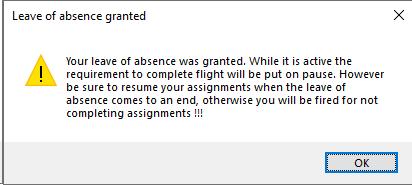
So the million dollar question ... when will this next version release? The short answer: I don't know, but I hope it will be within a few weeks, pending the results of a few more tests that I would like to perform. To get ready for the upcoming feature, you can start by adding all your simulator aircraft, or at least the ones you plan to use initially. The tutorial video recorded for version 1.17, which can be found in the Help menu (starting at 11 minutes and 15 seconds), demonstrates how to create user aircraft. Please note that what is currently referred to as "Simulator Aircraft" was previously known as "Owned Aircraft" in this video. Additionally, the next version of Flightplan Visualizer will be targeting the .NET Framework version 4.8.1, which is necessary for running the application. If you haven't installed this framework yet, you can download it from this link: https://dotnet.microsoft.com/en-us/download/dotnet-framework/net481. You only need to download the runtime version.
-
 1
1
-
-
You are welcome Bernd. One of the things that have changed in version 1.22 is that when you go into the Airport-info form it will now default to show ALL traffic into/out-off this airport, even if a flightplan have been selected in the main-form or you have performed a leg-search. So by default it will show ALL flights with no restriction (hence will also disregard the filtering by weekday.
In order to ONLY see the flights of the selected flightplan or an active leg-search you need to go to the "Traffic-Charts" tab-page. Here you find the combo-box labeled "Traffic to chart" (as marked below). Here it will now in version 1.22 default to the value "All flights to/from this airport". You need to change this value to "Selected flightplan or last-search on main-form". This will both change what is charted, and the flights that are listed in the "Traffic-legs" tab-page:
-
 1
1
-
-
I noticed a small issue regarding the naming of a few older Biz-jet flightplans, that does not follow my normal naming-scheme. On my system I will fix these names, hence for a future release these will have a different name than the names of the files bundled with version 1.22. I suggest that you also rename these files on your system to prevent you potentially could have the same flightplan more than once (if you both will have it with the current/wrong name, and the changed name from a future installer). Also I've begun working on version 1.23 where I've added a new feature to try to automatic try to detect obsolete flightplans, where it will try to locate "the same filename" with different seasons (e.g. "Air Belgium - Su21.bfp" and "Air Belgium - Wi21-22.bfp"). For this feature to work, the naming of the flightplans must follow the default naming-scheme, hence another reason to rename these following files. Here below is the list of filenames to change (from/to):
- "Bz_Auburn University Su18.BFP" -> "Bz_Auburn University - Su18.BFP"
- "Bz_Baldor Electric Su18.BFP" -> "Bz_Baldor Electric - Su18.BFP"
- "Bz_Paramount Pictures Su18.BFP" -> "Bz_Paramount Pictures - Su18.BFP"
- "Bz_Philip Morris Intl.BFP" -> "Bz_Philip Morris Intl - Su18.BFP"
- "Bz_Textron Su18.BFP" -> "Bz_Textron - Su18.BFP"
Last but not least I noticed I had two different seasons of flightplans for Tyson Foods active at the same time ("Bz_Tyson Foods - Su18.BFP" and "Bz_Tyson Foods - Su22.bfp"). I still need to check the installer if version 1.22 is bundled with both, and/or I forgot to flag the Summer-18 as obsolete. Anyway if you have both installed you should ideally remove "Bz_Tyson Foods - Su18.BFP", but for future installer I will both ensure it is not included and marked as obsolete.
-
You need to import the zip-file into Flightplan Visualizer (don't manually unzip it). As FV is no longer able to directly download FP, I use AIG AIM to download these FP. BEFORE you install a new FP into AIG AIM you can navigate to the "Online" tab-page in the flight-plan section. Here you will both have an "Install" and "Download" button next to each (non-installed) FP. You need to download them individually, by pressing the "Download" button next to each FP you want to download. These will download as ZIP-files, and its these ZIP-files you need to import into Flightplan Visualizer.
If you want to import FP into Flightplan Visualizer, that are already installed into AIG AIM, you will need to first uninstall them in AIG AIM (otherwise you will not see the download-button, which allows you to download the ZIP). Once the FP is downloaded as a ZIP to your hard-drive, you can re-install the FP into AIG AIM again.
The just released version 1.22 of Flightplan Visualizer have all FP that AIG had released up til about a week ago. However having just open AIG AIM on my system I can see that AIG have been very busy since then, as it shows 3 "Not Installed" FP and 46 "Updated".
If- and when you install the updated FP it will be your own responsibility to disable older versions of those FP. E,g, among my "Updated" I can see there is a "2022 Summer" FP for "AirBaltic" where there is currently bundled an "AirBaltic - Su21" with Flightplan Visualizer. So if you only want one of them active in Flightplan Visualizer you would need to remove the "AirBaltic - Su21" (can be done with the "Enable/disable flightplans" menu-item in Flightplan Visualizer.
-
 1
1
-
-
Its been more than a year since the release of version 1.21.1, however now finally version 1.22 is here, and the installer comes bundled with with 1599 pre-imported flightplans, and +300 airline logos (optional install). As usual the installer is available for download from AVSIM using this link:
https://library.avsim.net/esearch.php?CatID=msfs20util&DLID=226777If you have AIG AIM (AI Manager) installed on your computer and you have installed all/many of the trafic-files, you will have a folder on your computer containing airline logos for those files, and in settings of Flightplan Visualizer (FV) you can now specify the path to this folder (it should suggest the right path for you to pick). However if you don't have/use AIG AIM I've made a separate download containing +1400 airline logos (in a special ".CAL" format only for use with FV). This additional download is also available via AVSIM using this link:
https://library.avsim.net/esearch.php?CatID=msfs20util&DLID=226778These additional airline logos comes without an installer (its simply a .ZIP file containing these +1400 .CAL files). But before you try to put these additional logo's on your system you should first download, install and run FV version 1.22. Doing so FV will create a "LogoCache" folder where these ".CAL" files should be placed. Here below is the full path to that folder, however you should naturally replace "[User-Name]" with your actual windows user-name:
C:\Users\[User-Name]\AppData\Roaming\FlightplanVisualizer\LogoCacheAs per usual I have recorded a video explaining the delay for the release of version 1.22, and whats new in version 1.22. To see this video you can use the link below, or you can simply access it via the "Help" menu within FV (where you find menu-item for all of the tutorial videos):
Here below is a full history-list of all that have changed in this version (at least all I am prepared to share of what have changed):
- I had initially added a feature to download AIG airline-logos, however a later change in AIG's server setup rendered this feature useless. In stead you can now specify the local folder holding AIG's airline logo's (if/when you are using AIG AIM on your computer for AI-traffic). If specified, airline-logo's will be obtained from this folder.
- On the same note, I had to remove the menu-item to download AIG flightplans, as this program no longer have directly access to the AIG servers. For the same reason the menu-item to access the index with flightplans (up to summer 2021) was re-enabled.
- In the past when opening the Airport-Info form it defaulted to show in-/out-going traffic for the selected flightplan or active leg-search only. Now there is a new setting where you can set it up to in stead default to showing all traffic in/out of the airport (the Airport-info form still contains a combobox where you maually can choose what to see).
- "Owned aircraft" was renamed into "Simulator-aircraft", as these are the (flyable) aircraft you have available within your simulator of choise.
- When choosing to use calculated flight-times in a leg-search, you can now specify a percentage-difference (between leg-time and calculated-time). Only when the difference between leg-time and calculated-time exceeds this specified value will the calculated time be used during leg-search (e.g. "only use calc-times if diff. exceeds 50%, otherwise use leg-times").
- Began using (aircraft) short-names many places where the program in the past used IATA/ICAO-code (e.g. when hovering the mouse over a route, or list of aircraft servicing specific airports when editing flightplans). Also added short-name columns to aircraft browser and when choosing favorites (these stil contains columns for IATA/ICAO-codes).
- Pressing the "Usage" button when editing/viewing an aircraft-type or right-clicking an aircraft-type in the browser and choosing "View usage-report..." from the context menu, you will be shown a report that inform you how that aircraft-type is used: which simulator-aircraft are based on that type, which owned aircraft that have been marked as substitute for that type, which airlines are using that type (as carrier/operator), and finally in which (active) flightplans that type is used.
- Items in airline-browser are now by default sorted by (airline) name, and the usage-column shows the size of the airline if its in use. If available a logo for the selected airline is displayed in the upper/right corner.
- Improved performance when searching for ICAO-codes in the airport-browser. Also improved priority of the default selected item, in cases when an airport had a 3 letter ICAO-code, and another was using the same 3 leters for its IATA code.
- When searching for ICAO/IATA-codes in the airline-browser, it will now prioritize non-defunct airlines, if multiple airlines share the same ICAO/IATA-code.
- When enabling/disabling flightplans, you can now select all BizJet flightplans (those prefixed with "Bz_"), all Military (prefixed with "Ml_") or all Goverment (prefixed with "Gv_").
- Individual FP sub-folders can now be setup to leave (not move) defunct- and/or obsolete FP, even if the settings to automatic move these to the disabled folder is set.
- Performing "Search legs" you can now filter on aircrafts you are allowed to fly via type-ratings ("Must be type-rated").
- Performing a substitute of a user-airline, that airline will remain selected (previously the list scrolled to the top, and selected the 1st item).
- Added new check-box to "Search legs" that can exclude round-trips (legs taking-off and landing at same airport).
- Airline/Aircraft-repaint -filter can now filter on size of airline (e.g. "size=major"). Size is determined from usage as carrier/operator in active flightplans. Airlines not in use by active flightplans are listed with a size of "unknown").
- Added GPS-conversion (deg <-> deg,min,sec) to the conversion-form, as requested by a colleague. You can either manually enter lat/lon or look-up an airport to get it. There is both a primary lat/lon and a secondary, and the form will show the (GC)distance between these and the initial/final course.
- Added new "Max airport-distance" for airport-redirections. At the same time added new feature when importing/editing airports to permanent change an airport. If used, it is not saved/handled as a redirection (can't be restored) but rather as a perpament change.
- Reordered- and renamed some of the tab-pages in the Airport-info form.
- Reordered the length/distance-fields in the unit-conversion form.
- The Wind-calculator have been removed from the main-menu, in stead wind-calcuations can now be performed using the unit-conversion form. Also now the speed of the wind is always displayed as a positive value, and in stead the label will either say "Head-wind" or "Tail-wind".
- Added new "Country list" menu-item in the misc-menu. Will list all countries twice (sorted by names, and sorted by ISO3-codes).
- Showing airport-marker tool-tips on the main-map is now prioritized over showing route tool-tips.
- Added "Min take-off fuel ("MTFL") field to user-aircraft weight-fields. As of now its not set for any aircraft in the database, however it can be estimated as 60 minutes of flight at cruise.
- Moved several group-boxes of the settings-form to the 2nd tab-page, and added new fields for defalt simulator/logging-environment based on the File-prefix used when starting the program.
- Also now the header-names that was previous fixed to "Rank" and "Traffic-density" can be changed, so the selectable 6 values can be used for something entirely different, if anyone have the need for this. If/when changed, these new names are shown when editing an airport, or when performing a leg-search (as the leg-search can filter on these fields).
- MakeRunways (MkRwy) by Pete Dowson is challenged handling unicode in the scenery it scans/writes to XML. E.g. the Icelandic airport (BIFL) "Flúðir Airport" is exported by MkRwy as "Flúðir Airport". In this version FV will try to identify when this happens, and then it will fall back using the airport/city-names from the databases bundled with FV. This is not a perfect solution, but at least it improves the result.
- Various minor changes and tweaks to multiple forms (e.g. Unit conversion form can now be closed with ESC, renamed log-archives and so on).
- Fixed: If the main-form had an active flightplan filter when using the search-legs feature the flightplan combo-box still only contained the filtered context. Pressing the Clear button did not resolve the issue.
- Fixed: Since adding support for the AIGFP file-format, there could be flights departing from- and arriving at the same airport (e.g. helicopter flights). In previous versions the calculated flights-time would only consist of taxi-out/in times. In this version the flightplan leg-time will now also be uses for the calculated time, when the same airport is used both for departure and destination.
- Fixed: In some cases re-processing flightplans (resetting and performing redirection) could corrupt the flightplans and remove airport-data from the flightplans. This version will also try to add any missing airport-data to flightplans when re-processing them.
- Fixed: Selecting "only show favorites" in the Search aircraft-type form would filter out all aircraft (including those marked as favories).
- Fixed: In the leg-info form the fields to show times (Out, Off, On, In) were too narrow for multi-week flights, when showing the week-number (e.g. "TH7/14:37").
- Fixed: Issues when estimating cruise/taxi fuel-burn for user-aircraft, where in some cases some fields were not saved, and wrong calcuation if setup to show weight in Kg.
- Fixed: In some cases wrong TimeZone was used when calculating local time for OUT, OFF, ON, IN-times.
- Data: The airport redirection file ("UserAirportRedirect.xml") in the UserData folder have been updated to match the latest MSFS world update. However this new file is only installed by the installer if it does not already exists (in case you made your own changes), hence you need to delete this file manually prior to running the version 1.22 installer.
- Data: Quite a few airports in the airport-database were updated (had wrong names due to issues with unicode-letters). Also some additional airports were added.
- Data: The installer comes bundled with +300 airline-logos (optional install), and a separat package of +1400 airline-logos are avilable for download from AVSIM (in both cases these are encoded into a propriotary format using the ".CAL" extension).
- Data: Added the P2F (Passenger-to-Freighter) versions of the Airbus A320, A321 and A330. Also added the package freighter versions of CRJ100 and CRJ200.
- Data: Improved detection of Boeing 737-700/800 BCF/BDSF when importing flightplans utilizing these (passenger aircraft converted into freighters). Also improved a few other freighter detections.
- Data: Changed a few (aircraft) short-names to either shorten them a bit, or make them "more readable".
- Flightplans: All new/updated flightplans have been added to the installer, and all obsolete/defunct have been marked/removed. A total of 1599 active flightplans are bundled with the installer.
-
That feature is sadly not available any more, as AIG have moved to a new server-setup that Flightplan Visualizer (FV) cannot access. For the same reason the menu-item for downloading FP have been removed from FV 1.22. However if you have the traffic-files on your disk, they can still be imported into FV. Version 1.22 of FV comes bundled with 1599 FP (containing all AIG up to summer 2022)
-
As written yesterday, for version 1.22 I have added code to (try to) detect when there is an issue with unicode-letters in the name-fields (typical name of airport and/or name of city). If/when this is detected FV will in stead use the name from the airport-database bundled with FV (updated for version 1.22, for the same reason). However this will NOT change the fact that illegal chars in the XML will prevent FV from reading the Runways.xml file.
Running into this issue again yesterday made me rethink how I could try to handle the issue with illegal chars the name-fields of Runways.XML. In the past FV have always read the Runways.xml file, as one large (+90 MB) XML-file containing information of all +40000 airports scanned from the scenery. But as written here it meant the entire import failed if this file contained a single illegal char. As a new feature in version 1.22 FV will catch if- and when an error occur reading Runways.XML. If an error occur a new message-box (below) will appear informing the user of the issue, and it will ask the user if a new setting called "Robust 'Runways.XML' reading" should be enabled or not:
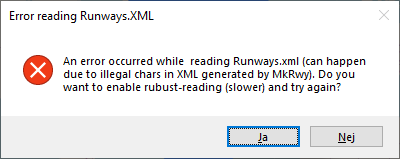
If you choose "No" ("Nej" here in my Danish version) the program will work as it did in the past (not being able to read the Runways.XML file). However if you in stead chooses "Yes" ("Ja" in Danish), the Runways.XML file will be split into many small XML-sections (one for each airport), and then all of these sections are being imported in parallel. It will cost some extra CPU power, it will cost some more memory (only during import) but it will allow FV to import the file. If there is an issue with an illegal char in the XML for a single airport (as was the case with "CAN9" yesterday) it will detect this issue and it will make sure the name-fields for this one/single airport are "groomed" to remove any offending chars (data for all other airports will import without the XML needs to be "cleaned" for offending chars). So if you run MkRwy at a later time (e.g. after a future "world-update") the issue with illegal chars in the XML might have disappeared and you can try to go to settings and disable it. Worst case the issue is still there, so simply re-enable the setting on start-up.
For the more nerdy users (like myself) I will probably want to "hand-edit" my XML to remove these illegal chars if/when they are being detected, but it will require you to look through the log-file to find the specification of where in the XML the issue was detected, and then you will have to manually load the XML, find the location, and edit the file. This new feature is just a matter of accepting to enable it if/when the issue is detected on start-up, and it will log the issue in a more readable fashion:
18:31:25.987|15|INFO |Load Runways.xml (MkRwy) from file: G:\FS\MakeRunways\runways.xml
18:31:26.522|15|INFO |Using normal import of MkRwy Runways.XML file
18:31:26.945|15|ERROR|An error occurred while reading Runways.xml (can happen due to illegal chars in XML generated by MkRwy).
18:32:16.109|15|INFO |User decided to enable robust-reading
18:32:16.122|15|INFO |Save App-settings(xml): C:\Users\pelle\AppData\Roaming\FlightplanVisualizer\UserData\Settings.xml
18:32:16.146|15|INFO |Using robust import of MkRwy Runways.XML file
18:32:18.704|14|WARN |Had to use robust import of MkRwy airport: CAN9
18:32:19.279|15|INFO |Airports imported (MkRwy): 41100The log clearly states what happened, and that the user chose to enable this new setting. Also in the second last line you can see it occurred importing the XML for the "CAN9" airport, so if you want to hand-edit the XML (remove the illegal char), you in this case simply have to search for the "CAN9" airport. But the less nerdy can simply enable the feature and disregard the log, and the hand-edit part.
-
For those of you running MkRwy to update the files you use with Flightplan Visualizer (FV) it appaers MkRwy have an issue with the latest (Canada) WU for MSFS ... at least on my system.
When scanning the scenery for the airport "CAN9" ("Château Frontenac") it inserts an illegal char in the generated "runways.xml" file. This illegal char prohibits FV reading this required file, hence FV cannot start-up. If any of you runs in to this issue, you can manually edit your "runways.xml" file, however you need an editor that can load such a large file (when I generate it, I include all runways longer than 1500 feet, hence the generated file will be some +91 MB). When loaded into an editor (I use the 64 bit version of NotePad++) search for "CAN9". If you run into the same issue as me, you should see the illegal char in the "ICAOName" field (NotePad++ will show it in reversed colors). Simply paste in a new name without the illegal char "Château Frontenac").
Generally MkRwy is somewhat challenged when it comes to airport-/city-names with unicode-letters (like "â"), so even if not adding illegal chars to the XML, airport/city-names might not show correct in FV. In version 1.22 FV will try to detect these wrong names in the XML, and once detected it will try to in stead fall back and use the names from the airport-database. For the release of 1.22 I have been going through the airport-database and fixed many names that were wrong for airport/cities (also issues with unicode-letters).
-
Since the last release (1.21.1) I've kept busy working on a brand new feature-set (to be discussed at a later time), and I've added many new features and fixed various issues I came about, and as usual I also made many updates the databases that are used by Flightplan Visualizer (FV). Once such new feature already mentions was the feature to download and display (AIG) airline-logos when browsing airlines. Also I made various changes to the feature of directly downloading AIG (AI) flightplans to be imported into FV. However all these new/updated features went out of the window the second AIG had to move to a new server-setup to cope with the increased bandwidth requirement of all the new users using AIG AIM/TC to inject AI-traffic into MSFS. For a long I was waiting to see if/when AIG was able to again offer the ability to download airline-logos and flightplans directly into FV, however sadly this is no longer an option.
For quite some time Flightplan Visualizer was put on the back burner, while I weighted my options as to what to do next, and in the meantime I chose to use my spare-time on other projects that needed my involvement. For those who might be interested, one such project is a program I released last year being able to produce (audio) single-cycle waveforms that can be loaded into hardware/software synthesizers/samples. In August this year I released a new version of this program (Waveform Generator), with a new feature of being able to also generate (audio) wave-tables. If interested here at this url, you can find videos explaining how the software can be used, and you also find a download link (the software is free, but only available for Windows): http://www.infinite-noise.com/WaveformGenerator.aspxAnyhow back on track. With the update for Waveform Generator being released, I could again return my focus to Flightplan Visualizer. Sadly I've had to remove the feature to download (AIG) flightplans directly into FV, as these are no longer available to external software. Also I had to remove- or at least totally rewrite the feature to download the AIG airline-logos. In stead I now have to manually download the AI flightplans (externally, not using FV), and once these have been downloaded, I can import them into FV. I guess most users are not themselves downloading/importing flightplans, so this will only be an issue for myself and those who did download flightplans themselves.
Likewise since the AIG airline-logos are no longer available for download by FV either, I've had to do the "next best thing". If you are using AIG AIM, it will download the airline-logos to a local folder for the flightplans you are using with AIG AIM/TC. So in settings of FV you can now specify the location of this folder, and FV will then use the airline-logos it finds in the folder, together with the new LogoCache folder added in version 1.22.
Just last weekend I manually downloaded and imported 3-400 new/updated flightplans that have been released since FV was last able to download flightplans. Most of these are updated versions of flightplans that already are bundled with FV, but there are also many brand new flightplans, for airlines that are not available in the currently released versions of FV. While downloading all these new/updated flightplans I had an issue with about 5 of them, but I have a good idea of what went wrong, and where I have to look in the code, so I think (hope) it will be a quick fix, to import these few remaining flightplans.
For a long time it was my plan to release version 1.22 with "the new feature-set" enabled. But even though I had already spend a long time working on this feature-set I still have quite a few items on my "to do list" before I am ready to release a version enabling these new features. So in stead I want to release version 1.22 with most of these new features disabled. However there will be some forms that have added fields/columns that might hint about the new feature coming later, but it will not break the software in any way.
So I hope to be able to release version 1.22 (bundled with all the new/updated flightplans) within this or the next week, pending on if the last items to iron out are to be completed as I hope/plan.
-
 1
1
-
-
Thanks for the kind words Arek.
Regarding import of flight-plans I can't offer batch/bulk import. The (AI) flight-plan file-format is not 100% aimed at how I use the data within Flightplan-Visualizer (FV). Hence when you import a flight-plan you might see a warning, and you are suggested to look over how it actually imported, as there might be things that needs to be fixed. For instance FV will try to detect which airline is servicing these flights. In most cases FV will detect the correct airline, but in some cases it might not (in some cases the airline might not exists within FV's internal data-base, so it has to be added first, or it might exists with another ICAO-code and/or name). Likewise it will try to detect which aircraft are servicing the flights, and it does a very good job in this aspect, but again in some cases it might not. Likewise FV will try to detect which airports are used to service the flights, and again in most cases it does a good job, but it some cases it does not get it 100%. This all comes down to the data-files AIG is using now/have used in the past, and the data-files FV is using internally. There are differences in this files (e.g. AIG might use another ICAO-code for an airport than FV does). ICAO-codes are not fixed, they do change sometime. This is the reason Flight-plans needs to be imported one at a time, and you "need to" (or at least: "you should"), look at each import to see that it imported as it should.
You don't have to, but each time I import a flight-plan I pay attention to the names of the aircraft (repaints) in used by that airline. if the name of an aircraft contains "opb" or "opf" I use these information to set the carrier/operator for that airline. When the name contains "opb" it indicate the flights services by that airline is "operated by" another airline. E.g. an aircraft for a SAS (Scandinavian) flight-plan with "opb CityJet" in the name will indicate that SAS the the carrier, however CityJet is the operator. Likewise if the name in stead contains "opf" in the name it indicate that this aircraft is "operated for" the specified airline. Setting up the Carrier/Operator for the imported flight-plans is a manual process, hence another reason batch/bulk import is not possible.
When it comes to the old AIG Flight-plans (dating back to 2008) you might not be able to import then all, and even if you are its more important that you look over each import and verify that it imported correctly. I don't think I tried to import anything older than 2015 myself. However in the older flight-plans AIG was less consistent in the way they made these files, than they are today. I guess thise days their internal tools for building these flightplans, assist them much more and is one of the reasons these files are more consistent. The more consistent these files are, the better FV is at detecting the correct: airlines, aircraft and airports.
EDIT:
Regarding the download not working in FV it is because AIG have moved their flightplans to another server setup, and as of now they can't grant access to FV being able to download these. Hence you have to download them manually (outside of FV). But once downloaded you can import them (1 at a time).
AIG don't support flight-plans for ALL airlines, and they are not updated for each airline for each year. While I don't know their internal process for choosing which airlines to update each year. I guess it based on multiple factors. E.g. how easy is it to obtain the data needed to construct a flightplan, when was the last time a flightplan for this airline was made, and perhaps even personal choice of the person who generate the flightplans. Hence me as a Dane/Scandinavian I would perhaps be more interested to add a flightplan for a Danish/Scandinavian airline, or an airline with whom I had flown in real life. So I guess many factors are in play to affect for which airlines they create flightplans- and how often these gets updated.
But since their flightplan are used for AI traffic, another important factor is also for which aircraft do they have (AI/3D) models, and repains. The real-lift airline might have additional flights for aircraft for which there is no AI aircraft-models available, hence either they would have to omit this data from their AI flightplans of they would have to select a substitute aircraft (model).



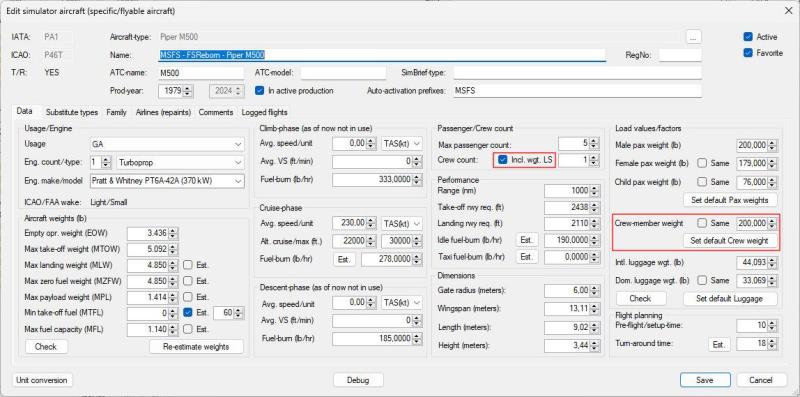
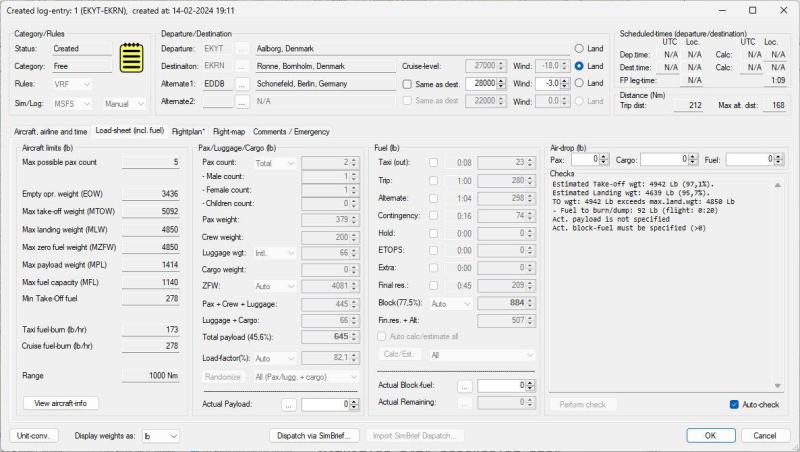

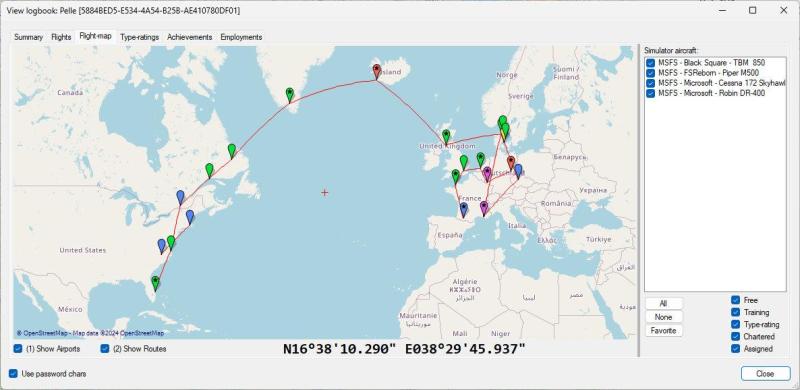
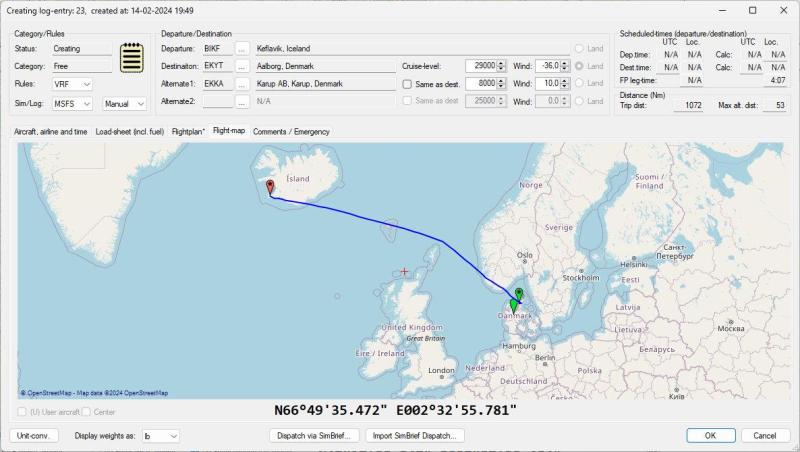

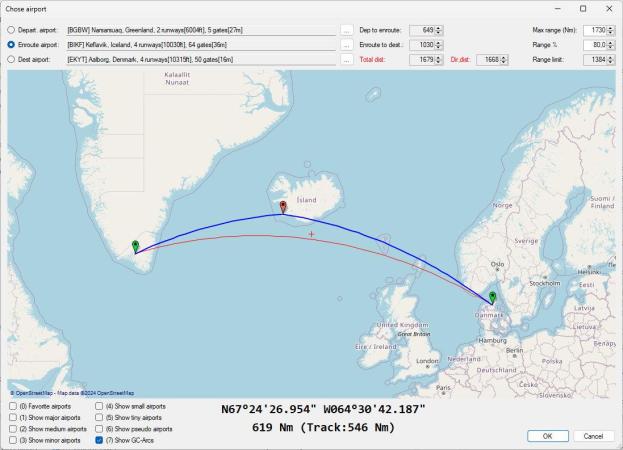
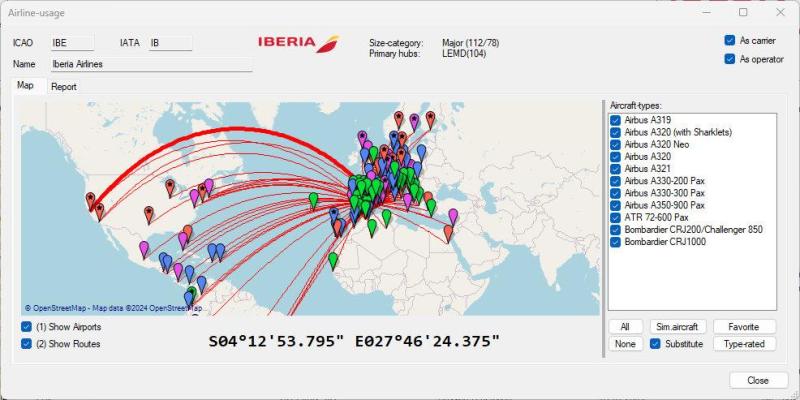


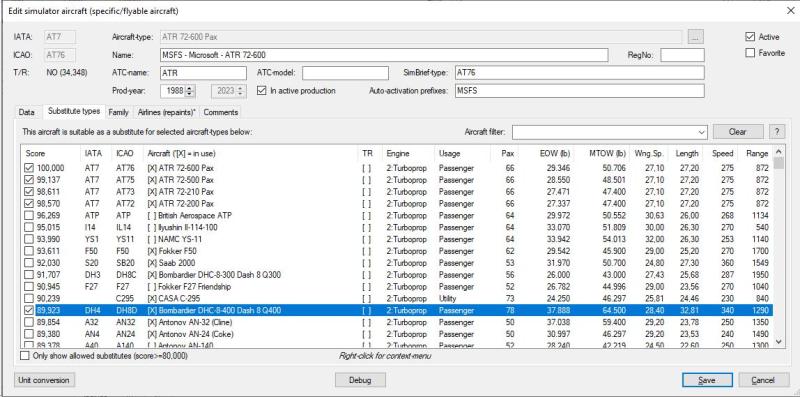

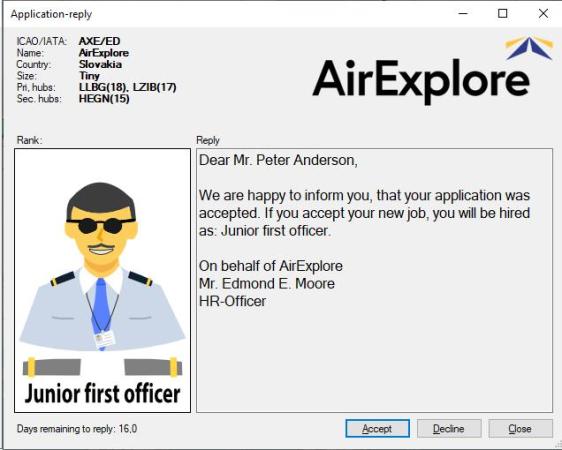






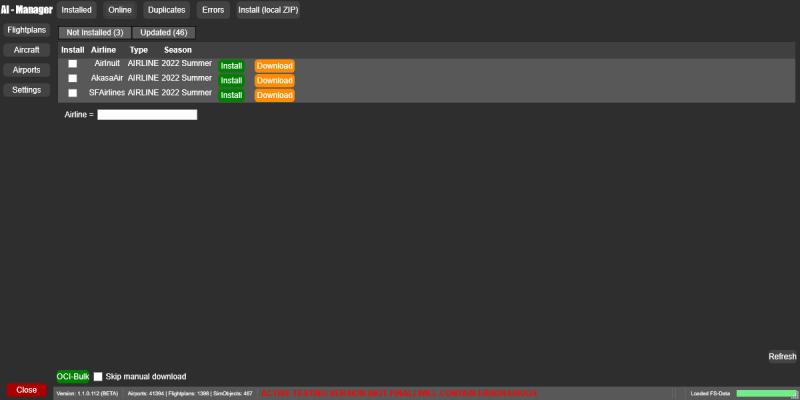
Version 1.24 of Flightplan Visualizer released
in Flightplan Visualizer
Posted
In a previous post I posted the link to the tutorial-video recorded for version 1.24, and as per usual this video can also be accessed from within the program using the Help-menu. Version 1.24 primarily contains enhancements to the logbook/employment-feature added in version 1.23 (that was released in January). However it also contains new/updated flightplans, bringing the total count to 1823. If you have not yet updated to version 1.23, remember that you need to ensure that .NET Framework 4.8.1 is installed on your system (can be downloaded using the link below, you only need the runtime). The installer for version 1.24 is now available via AVSIM using the following link:
https://library.avsim.net/esearch.php?CatID=msfs20util&DLID=229504
https://dotnet.microsoft.com/en-us/download/dotnet-framework/net481
If you have used the logbook/employment feature, I urge you to do a backup of your logbook BEFORE updating to any new version. You can either navigate to the UserData folder (e.g. via the menu-item in the File-menu) and backup the .LBK file, or clone your current logbook via the "Manage logbooks" menu-item found in the Logbook-menu. In version 1.23 when cloning a logbook, it will automatic switch the the cloned logbook, so ensure you acess the "Manage logbooks" menu a 2nd time and switch back to the "correct" logbook (simply double-click it). Once version 1.24 have been installed, when cloning logbooks it will ask whether you want to switch to the cloned logbook or not.
Below is the full history of all changes and fixes in this version. One of the new features is the abillity to obtain the UTC-time from the simulator (to update the OUT/OFF/ON/IN-times of your active log-entry) and the amount of loaded payload and fuel. These data are extracted via FSUIPC, so in order to use this feature you must have FSUIPC installed (I have only tested with a paid version of FSUIPC, however it should work with the free version as well).
Changes/fixes in version 1.24